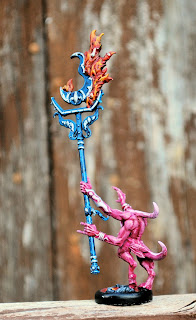
I guess that many wargamers these days start with Warhammer 40K but wargame veterans of a certain age (aka silly old farts) started with Airfix. When I was about seven my doting mater brought home this new toy, called an Airfix Spitfire kit in 1/72. From there I discovered tanks and little toy soldiers made of wobbly plastic. Then there were the Airfix modelling and Rule Books, which replaced rolling marbles against our armies. Airfix and I are almost exactly the same age.
Wargaming got more complicated during the seventies and eighties, until the games became almost unplayable. Do you remember the final version of WRG's WWII rules. Oh dear God, I do.
In the early nineties there was a move back to games; you know, playing with toy soldiers. A set of rules called Rapid Fire were written by Colin Rumford and Richard Marsh. I played them a few times but my interest in modern warfare had been burnt out by then.
However, there is now a new version of Rapid Fire. The name gives it all away. This is a fun game that can be played in an afternoon. It is wonderfully old fashioned but, best of all, is designed for 1:72 plastic toy soldiers. Oh joy, just perfect for a man going through his second childhood. You could play Rapid Fire from scales of 15mm to 28mm but, for me, it has to be plastic toy soldiers.
There are haunting similarities to 40K, another seventies game originally. We are in Charles Grant and Donal Featherstone territory here.
The game uses IGOUGO and is broken down into 1. Morale, Observation (of enemy units), Smoke, Heroic Actions, First Movement, Opportunity Fire (for the other player to fire units on Overwatch), Close Assault, Firing, Second Move (for units that have not yet moved).
The basic unit in the game is the figure, not an abstract concept like a stand (just like 40K). You play it with a few D6s and a D10.

The production quality is scrumptious, and 1/72 plastic toy soldiers are used for all the pics - Rumford and Marsh are men after my own heart. Of course, the other thing about 1/72 plastic models are that they are as cheap as chips in comparison to resin or metal, especially as the manufacturers have huge production runs - most of the cost of a plastic kit is in the mould production, the plastic is dirt cheap, but the moulds last nearly forever.

A soldier figure represents about 15 men, and a vehicle about five. This means that a battalion can be recreated on the table as the unit of manouvre, which is clever as modern armies fight in battalions, and combinations of battalions make up all arms-armies. 40K fudges this a bit. It sort of pretends to be a skirmish game but operates more like a traditional wargame where one figure represents many.
The above picture shows a 1944 German infantry battalion. The photos below show my recreation using a single box of Revell 1/72 panzergrenadier figures (for the princely sum of seven knicker). I broke with tradition and mounted them on plastic GW-type bases. 1/72 soldiers are made from a soft plastic that flakes easily when the plastic flexes. The stands protect the models. Incidentally, I have found the trick to painting soft plastic is to degrease thoroughly and then spray with a good primer.
I mount the figures on the stand initially with superglue in order to paint them but this is not a durable solution (don't even think of polystyrene cement. I finally coat the base with white glue to stick on decoration. White glue sets very hard and makes a good rigid fix.

So here we have the battalion HQ, five 'infantry' figures, and the 4th Heavy Company - nine figures with three 80mm mortars. At the back are a depleted light anti-tank company of eight men, with three Panzerschreckes.

Above are the 1st, 2nd & 3rd companies - each of seven 'infantry' men and a Panzerfaust man (to bolster the anti-tank capability). Note that the stands are of no importance - it's the figures that matter. Also note that the battalion has no 'points'. This is an old fashioned wargame where you are expected to refight historical scenarios - not play chess with toy soldiers.

The battalion has a company of heavy Tiger I tanks in support. There should be three troops but a third of the company has broken down in transit so it has been reorganised into two.

The Tiger I was a nasty surprise and was very difficult to knock out using the 76mm guns of T34s and KV1 heavy tanks. The Russian response was to mount a modified 85mm flak gun on a T34 chassis until the T34 could be retooled with a larger turret ring to take the new weapon. The SU85 self propelled anti-tank gun (SPAT) was only manufactured for a year as a stop gap. However, the concept was continued with an SU100 SPAT mounting an even larger weapon.
The Tiger may have been lethal but it was also highly unreliable and took four times the resources to make than a T34. The Germans produced a maximum of around 100 Tigers a month, the Russians produced 1000 T34s in the same time. You can make a similar argument for a Sherman. By 1944, the Germans had only 400 tank runners at any one time. The allied figure was an order of magnitude greater. The sophisticated Tigers and Panthers were swamped, most abandoned undamaged by their crew when they broke down or ran out of fuel.
Quantity has a quality all of it's own.
I have chosen to play the Russian front because this was where the European war was won and lost. All the rest was a sideshow.









































